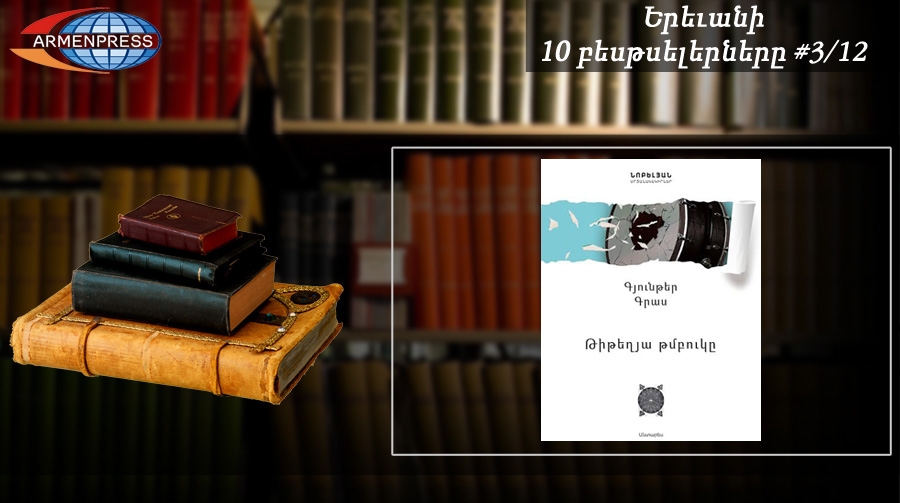"Armenpress" introduces bestseller books list 3/12
 10:00, 15 May 2015
10:00, 15 May 2015YEREVAN, MAY 15, ARMENPRESS. “The Daredevils of Sassoun” tops this week's "Bestseller Books List" introduced by "Armenpress" News Agency. The Armenian epic poem is introduced in different dialects with parallel French translation by Aida Charkhchyan.
In the initial decades following the discovery of the epic in the late nineteenth century a general consensus emerged attributing its theme to the struggle of four generations of Sassoun's warriors against Arab rule in the 8th to 10th centuries. The pioneers of this interpretation of the epic were the philologist Manoug Abeghyan in Armenia and academician Hovsep Orbeli in Leningrad who argued that there are no characters in the epic who could be attributed to a historical figure before the 10th century.
This historicist school held its sway until the Armenian philologist Grigoryan first in an article (1981), then in a book (1989) argued following an incisive analysis of the epic, "it is indisputable that the roots of the epic go back deep into the centuries, and they reach not only the cuneiform times when monarchy was underway in Armenia, but even the prehistoric era." Grigoryan identified various episodes in the epic as of patently matriarchal origin, prompting various scholars both in Soviet Armenia and elsewhere to probe deeper into the proto-layers of the epic.
The Daredevils of Sassoun is commonly cited as one of the most important works of Armenian folklore. This recital of the legendary deeds of four generations of strongmen in a warrior community in the Armenian highlands is in the tradition of heroic folktales that dramatize the story of a whole nation and voice its deepest sentiments and aspirations, but unlike such well-known epics as the Iliad and the Odyssey (Greek), Epic of Gilgamesh (Sumerian), Beowulf (English), Chanson de Roland (French), Cantar de Mio Cid (Spanish) and others one might mention, it has survived solely by word of mouth, transmitted from one generation to another by village bards. The literary merits of the Sasun saga surpass its value as a historical or linguistic document.
The performance of the Daredevils of Sassoun is included in the UNESCO Intangible Cultural Heritage representative list in 2012.
“The Book of Lamentations; Hymns'' by St. Gregory of Narek published by “Zangak” publishing house occupies the second position of the list. The mystical poem "Book of Lamentations" has been translated into many languages and has played a significant role in the development of the Armenian literary language. In 95 grace-filled prayers St. Gregory draws on the exquisite potential of the Classical Armenian language to translate the pure sighs of the broken and contrite heart into an offering of words pleasing to God. The result is an edifice of faith for the ages, unique in Christian literature for its rich imagery, its subtle theology, its Biblical erudition, and the sincere immediacy of its communication with God. This masterpiece by St. Gregory of Narek has always been included in our bestseller books list.
"The Little Prince" by French author Antoine de Saint-Exupéry published by Edit Print and Antares publishing houses occupy the third and fourth places respectively. The novella is both the most read and most translated book in the French language, and was voted the best book of the 20th century in France. The book was translated into more than 250 languages and dialects, as well as Braille.
Saint-Exupéry, a laureate of several of France's highest literary awards and a reserve military pilot at the start of the Second World War, wrote and illustrated the manuscript while exiled in the United States after the Fall of France. He had travelled there on a personal mission to persuade its government to quickly enter the war against Nazi Germany. In the midst of personal upheavals and failing health he produced almost half of the writings he would be remembered for, including a tender tale of loneliness, friendship, love and loss, in the form of a young prince fallen to Earth.
The Sandcastle Girls by Chris Bohjalian occupies the fifth place. Over the course of his career, New York Times bestselling novelist Chris Bohjalian has taken readers on a spectacular array of journeys. Midwives brought us to an isolated Vermont farmhouse on an icy winter’s night and a homebirth gone tragically wrong. The Double Bind perfectly conjured the Roaring Twenties on Long Island – and a young social worker’s descent into madness. And Skeletons at the Feast chronicled the last six months of World War Two in Poland and Germany with nail-biting authenticity. As The Washington Post Book World has written, Bohjalian writes “the sorts of books people stay awake all night to finish."
In his fifteenth book, The Sandcastle Girls, he brings us on a very different kind of journey. This spellbinding tale travels between Aleppo, Syria in 1915 and Bronxville, New York in 2012—a sweeping historical love story steeped in the author's Armenian heritage, making it his most personal novel to date.
When Elizabeth Endicott arrives in Syria she has a diploma from Mount Holyoke College, a crash course in nursing, and only the most basic grasp of the Armenian language. The First World War is spreading across Europe and she has volunteered on behalf of the Boston-based Friends of Armenia to deliver food and medical aid to refugees of the Armenian Genocide. There Elizabeth becomes friendly with Armen, a young Armenian engineer who has already lost his wife and infant daughter. When Armen leaves Aleppo to join the British army in Egypt, he begins to write Elizabeth letters, and comes to realize that he has fallen in love with the wealthy, young American woman who is so different from the wife he lost.
Flash forward to the present, where we meet Laura Petrosian, a novelist living in suburban New York. Although her grandparents' ornate Pelham home was affectionately nicknamed "The Ottoman Annex," Laura has never really given her Armenian heritage much thought. But when an old friend calls, claiming to have seen a newspaper photo of Laura's grandmother promoting an exhibit at a Boston museum, Laura embarks on a journey back through her family's history that reveals love, loss – and a wrenching secret that has been buried for generations.
“The Book of Lamentations; Hymns'' by St. Gregory of Narek this time published by “Nahapet” publishing house occupies the sixth position.
“Mother” by Henri Verneuil occupies the seventh place. Henri Verneuil was born on October 15, 1920 in Rodosto, Turkey as Achod Malakian. He was a director and writer, known for The Sicilian Clan (1969), The Night Caller (1975) and I as in Icarus (1979). He died on January 11, 2002 in Bagnolet, Seine-Saint-Denis, France. It was at the tender age of 4 that Achod Malakian arrived with his family in Marseille, joining thousands of Armenians in fleeing the Turkish government's massacres of their people. As Henri Verneuil, at the end of his life, he devoted his two final full-length features to this part of his childhood and heritage.
Born in Turkey and was a naturalized French citizen of Armenian ancestry. Former journalist, editor, film critic and radio commentator. Directed his first short film in 1946, his first motion picture six years later. Best known for his popular thrillers and action films, frequently starring Jean Gabin.
"1984" by George Orwell occupies the eighth position of the Bestseller Books List introduced by "Armenpress" News Agency. While 1984 has come and gone, Orwell's narrative is more timely that ever. 1984 presents a "negative utopia", that is at once a startling and haunting vision of the world — so powerful that it's completely convincing from start to finish. No one can deny the power of this novel, its hold on the imaginations of entire generations of readers, or the resiliency of its admonitions — a legacy that seems to grow, not lessen, with the passage of time.
Another book by the same author, "Animal Farm" occupies the ninth position of our list. Animal Farm is an allegorical and dystopian novel, published in Englandon 17 August 1945. According to Orwell, the book reflects events leading up to theRussian Revolution of 1917 and then on into the Stalin era in the Soviet Union. Orwell, ademocratic socialist, was an outspoken critic of Joseph Stalin and, especially after experiences with the NKVD and the Spanish Civil War, he was actively opposed to the controversial ideology of Stalinism. The Soviet Union, he believed, had become a brutaldictatorship, built upon a cult of personality and enforced by a reign of terror. In a letter to Yvonne Davet, Orwell described Animal Farm as a satirical tale against Stalin "un conte satirique contre Staline", and in his essay "Why I Write" (1946), he wrote that Animal Farm was the first book in which he had tried, with full consciousness of what he was doing, "to fuse political purpose and artistic purpose into one whole".
The original title was Animal Farm: A Fairy Story, though the subtitle was dropped by U.S. publishers for its 1946 publication and subsequently all but one of the translations during Orwell's lifetime omitted it. Other variations in the title include: A Satire and A Contemporary Satire. Orwell suggested the title Union des républiques socialistes animales for the French translation, which recalled the French name of the Soviet Union,Union des républiques socialistes soviétiques, and which abbreviates to URSA, the Latinfor "bear", a symbol of Russia.
“The Tin Drum” by Günter Grass occupies the final place of the rating list. The Tin Drum, one of the great novels of the twentieth century, was published in Ralph Manheim’s outstanding translation in 1959. It became a runaway bestseller and catapulted its young author to the forefront of world literature.
After more than fifty years, The Tin Drum has, if anything, gained in power and relevance. All of Grass’s amazing evocations are still there, and still amazing: Oskar Matzerath, the indomitable drummer; his grandmother, Anna Koljaiczek; his mother, Agnes; Alfred Matzerath and Jan Bronski, his presumptive fathers. And Oskar’s midget friends—Bebra, the great circus master, and Roswitha Raguna, the famous somnambulist; Sister Scholastica and Sister Agatha, the Right Reverend Father Wiehnke, the Greffs, the Schefflers, Herr Fajngold, all Kashubians, Poles, Germans, and Jews—waiting to be discovered and rediscovered.
To complete the bestseller list, the following bookshops have participated in the survey: “New Book” (093-60-40-64), “Noah’s Ark” (56-81-84), Armenian Book” (54-07-06), “Edit Print” (57-70-09), “Bureaucrat” (50-01-52), “Bookinist” (53-74-13), “Art Bridge” (58-12-84) and “Zangak” (23-25-28).
Completed by Roza Grigoryan




















